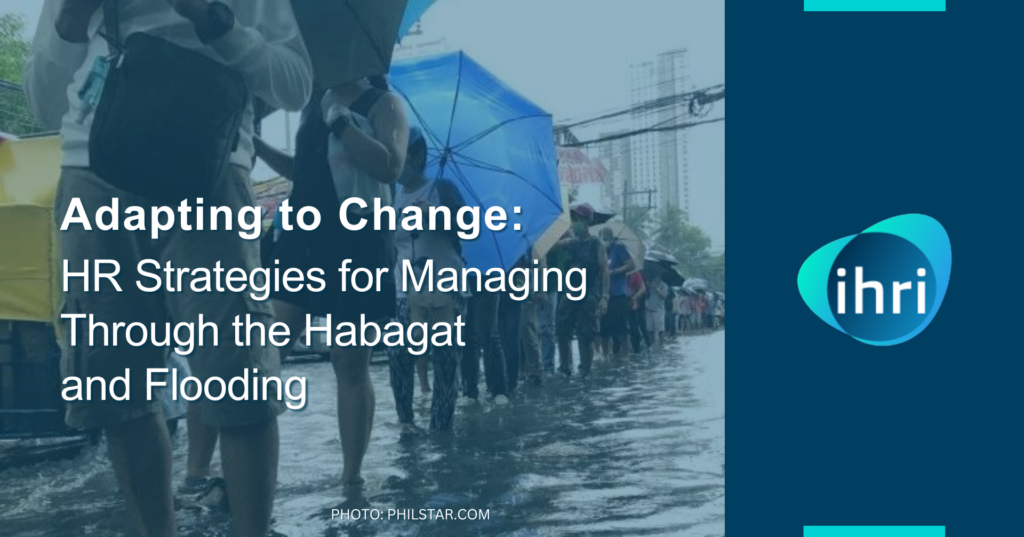The recent headlines in the Philippines have been dominated by the heavy rains and floods brought about by the southwest monsoon, locally known as “Habagat.” This weather phenomenon has caused widespread disruption, affecting many parts of the country, including Metro Manila, Quezon City, and several provinces. For HR professionals, these events underscore the importance of preparedness, resilience, and proactive management in ensuring the safety and well-being of employees. Here are some key strategies HR can adopt to navigate through such challenging times.
Understanding the Impact
The southwest monsoon has brought significant rainfall, leading to flooding in various areas. The state weather bureau, PAGASA, has issued warnings about potential flash floods and landslides due to severe thunderstorms (Philstar.com) (ABS-CBN News). These conditions pose not only physical risks to employees but also impact business operations, commuting, and overall productivity.
Developing Robust Contingency Plans
One of the primary responsibilities of HR during such crises is to ensure that the organization has a comprehensive emergency response plan in place. This plan should address various scenarios, from evacuation procedures to remote work arrangements.
Key Elements of an Effective Contingency Plan:
- Clear Communication Channels: Establish reliable communication channels to disseminate information quickly and efficiently. Use multiple platforms such as emails, SMS alerts, and internal messaging systems to keep employees informed about safety measures and updates.
- Remote Work Policies: Given the disruptions caused by flooding, enabling employees to work from home can maintain productivity while ensuring their safety. Ensure that all employees have the necessary tools and resources to work remotely.
- Emergency Contacts and Procedures: Maintain an updated list of emergency contacts and outline clear procedures for different types of emergencies. Conduct regular drills to ensure that all employees are familiar with these procedures.
Ensuring Employee Safety and Well-being
The physical and mental well-being of employees should be a top priority during such times. HR can play a crucial role in providing support and resources to help employees cope with the challenges posed by natural disasters.
Support Measures:
- Health and Safety Resources: Provide information on safety measures during floods, such as avoiding floodwaters and knowing evacuation routes. Distribute emergency kits that include first-aid supplies, flashlights, and other essentials.
- Mental Health Support: The stress and anxiety caused by natural disasters can take a toll on mental health. Offer access to counseling services and mental health resources to help employees manage their stress.
- Financial Assistance: For employees severely affected by the floods, consider offering financial assistance or emergency loans to help them recover and rebuild.
Leveraging Technology for Business Continuity
Technology can be a powerful ally in ensuring business continuity during natural disasters. HR can work with IT departments to implement solutions that support remote work and maintain operations.
Technological Solutions:
- Cloud-Based Systems: Utilize cloud-based applications and storage to ensure that employees can access necessary documents and systems from anywhere.
- Virtual Collaboration Tools: Implement tools such as video conferencing, project management software, and team messaging platforms to facilitate seamless communication and collaboration.
- Data Backup and Security: Ensure that all critical data is backed up regularly and that robust cybersecurity measures are in place to protect against potential threats.
Fostering a Culture of Resilience
Building a resilient organizational culture is key to navigating through crises. HR can foster resilience by promoting flexibility, adaptability, and a supportive environment.
Strategies to Build Resilience:
- Training and Development: Offer training programs that focus on crisis management, problem-solving, and adaptability. Equip employees with the skills they need to handle unexpected challenges.
- Encouraging Open Communication: Create an environment where employees feel comfortable sharing their concerns and suggestions. Open communication can lead to innovative solutions and a stronger sense of community.
- Recognizing and Celebrating Efforts: Acknowledge and reward employees who demonstrate resilience and go above and beyond during crises. Recognition can boost morale and reinforce a positive organizational culture.
Conclusion
The recent Habagat and flooding in the Philippines serve as a reminder of the importance of preparedness and resilience in the workplace. By developing robust contingency plans, ensuring employee safety and well-being, leveraging technology, and fostering a culture of resilience, HR professionals can effectively navigate through such challenges and support their organizations in times of crisis.
Becoming an Expert
International HR Institute provides global certification programs for modern-day HR professionals. Understand how to further provide these support measures by taking the Certified Practitioner in Human Resources (CPHR) and the Certified Compensation and Benefits Professional (CCBP) certification programs.


